The document details the implementation of list and search features in a distributed library application using Perl and C. It discusses client-server interaction, authentication, and multi-client handling using server design principles, particularly emphasizing an STM (Software Transactional Memory) design. It outlines how to create a server capable of managing multiple clients and provides pseudocode and methods for effective communication between clients and servers.
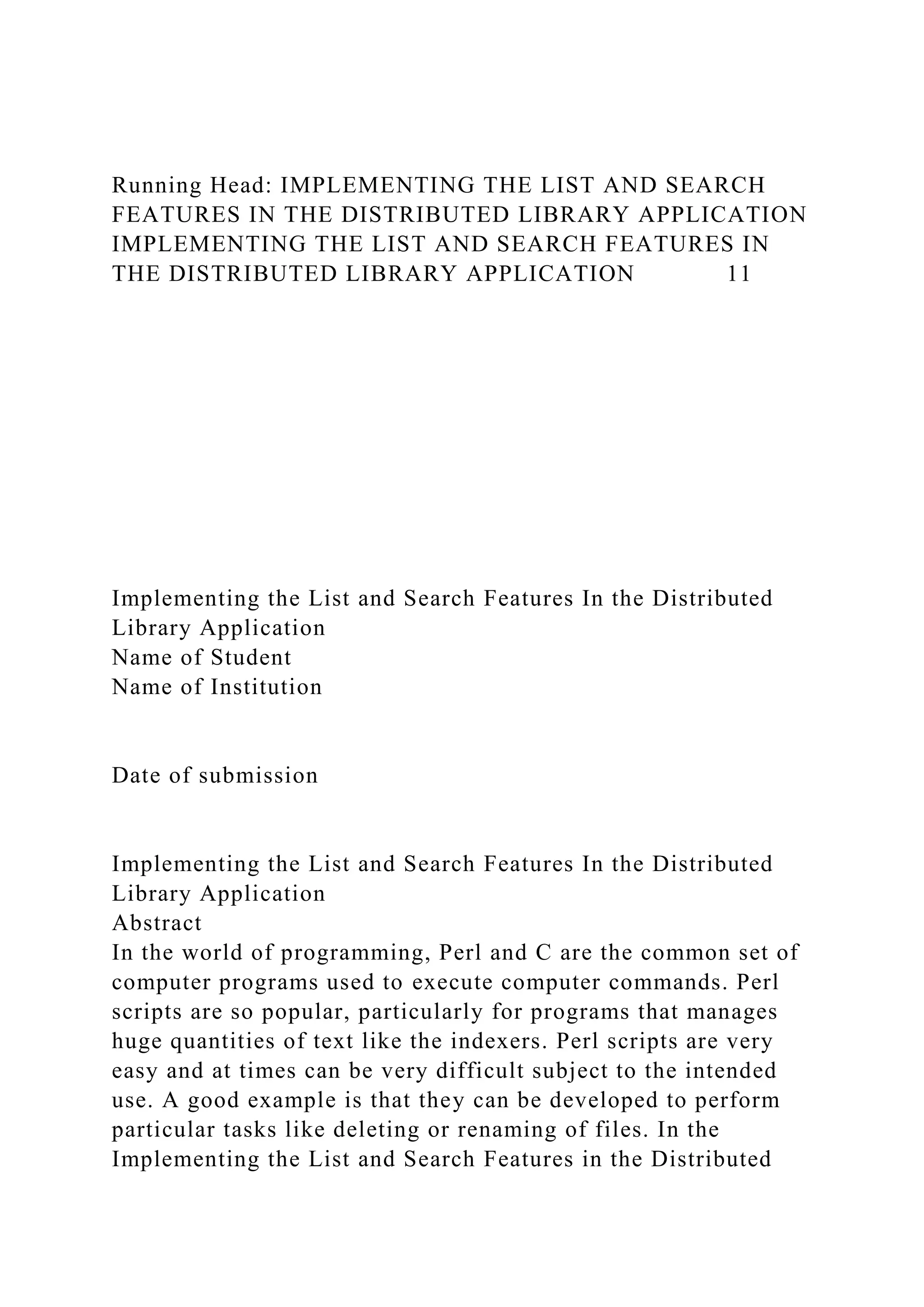
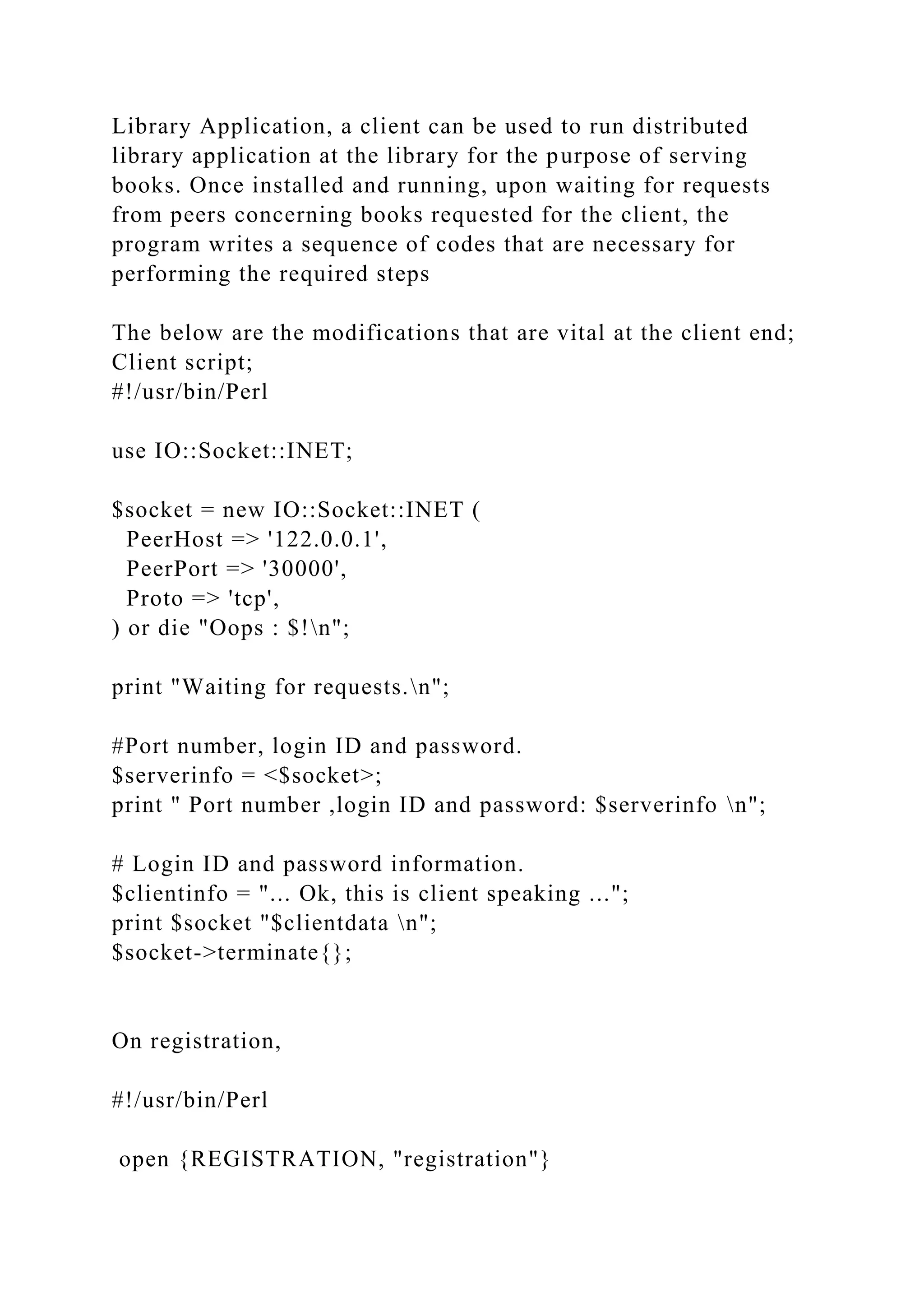
![die "Can't open registration: $!n";
· while {$line = <login ID, password, and port number(3302)>}
[
{$menu, $registration} = split{/ /, $line};
$registration[$menu ] .= $registration. " ";
]
Server script;
#!/usr/bin/perl
use IO::Socket::INET;
$socket = new IO::Socket::INET {
LocalHost => '122.0.0.1',
LocalPort => '30000',
Proto => 'tcp',
Listen => 10,
Reuse => 1
} or die "Oops: $! n";
print "Server is up and running ... n";
while {1} [
$clientsocket = $socket->registered{};
print " **** Recent Client Registered **** n ";
# Port number, login ID and password.
$serverinfo = "This is server speaking ...";
print $clientsocket "$serverinfo n";
# Login ID and password information.
$clientinfo = <$clientsocket>;
print " Login ID and password information: $clientinfon";
]
$socket->terminate{};](https://image.slidesharecdn.com/runningheadimplementingthelistandsearchfeaturesinthedis-221101170613-35f616ef/75/Running-Head-IMPLEMENTING-THE-LIST-AND-SEARCH-FEATURES-IN-THE-DIS-docx-3-2048.jpg)
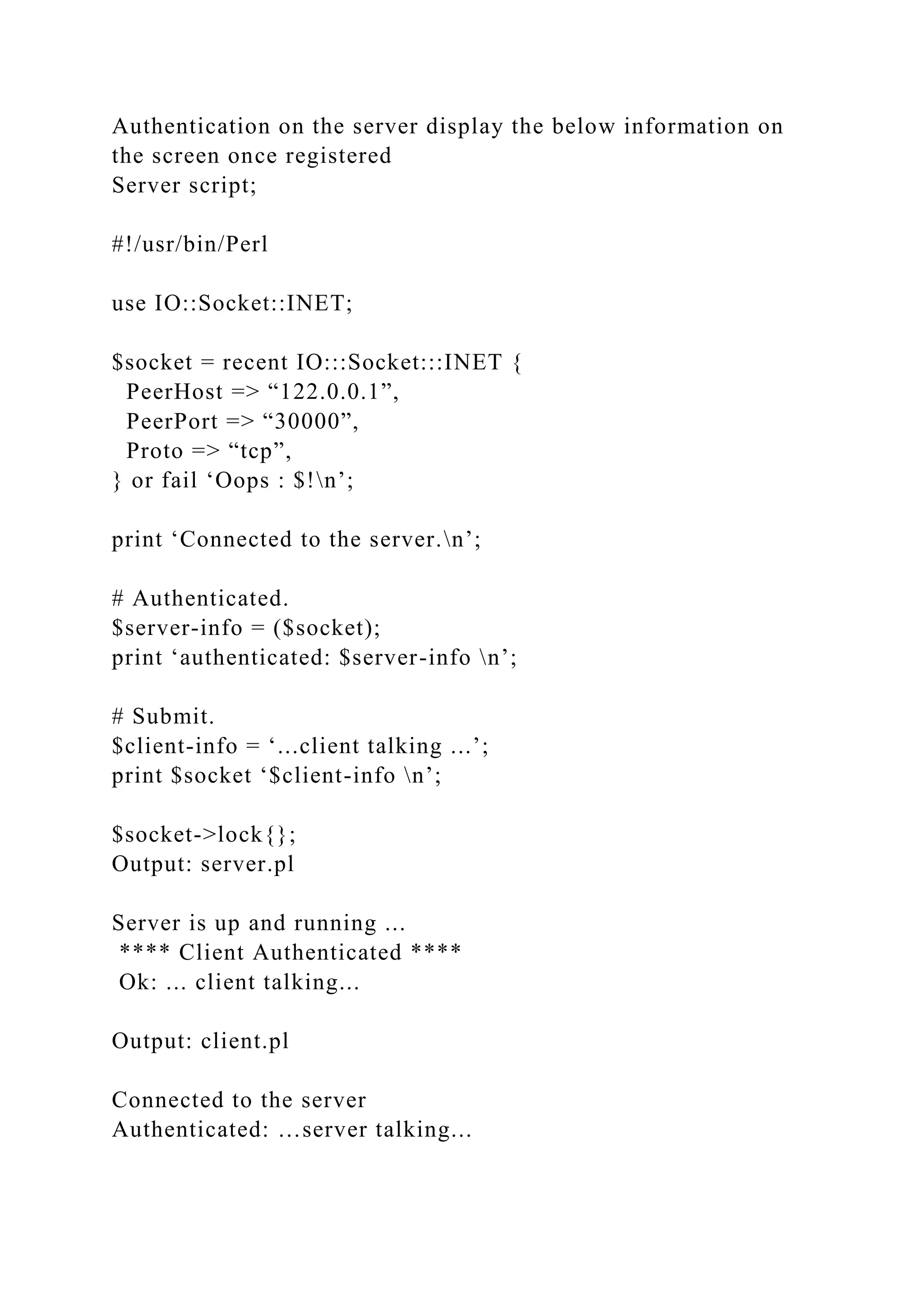
![Connected to the server
Authenticated: …server talking...
On receiving a reply from the server, the client arbitrarily picks
another client and contacts it with a time-of-day request
Client script;
#!/usr/bin/perl
use IO::Socket::INET;
$socket = new IO::Socket::INET {
LocalHost => '122.0.0.1',
LocalPort => '30000',
Proto => 'tcp',
Listen => 10,
Reuse => 1
} or die "Oops: $! n";
print "Server is up and running ... n";
while {1} [
$clientsocket = $socket->registered{};
print " **** Recent Client Added **** n ";
# Port number, login ID and password.
$serverinfo = "This is server speaking ...";
print $clientsocket "$serverinfo n";
# Login ID and password information.
$clientinfo = <$clientsocket>;
print " Login ID and password information: $clientinfon";
]
$socket->terminate{};
A copy of your client and server programs implementing the
distributed library application.
The server initiates the thread and on the screen, the following](https://image.slidesharecdn.com/runningheadimplementingthelistandsearchfeaturesinthedis-221101170613-35f616ef/75/Running-Head-IMPLEMENTING-THE-LIST-AND-SEARCH-FEATURES-IN-THE-DIS-docx-5-2048.jpg)
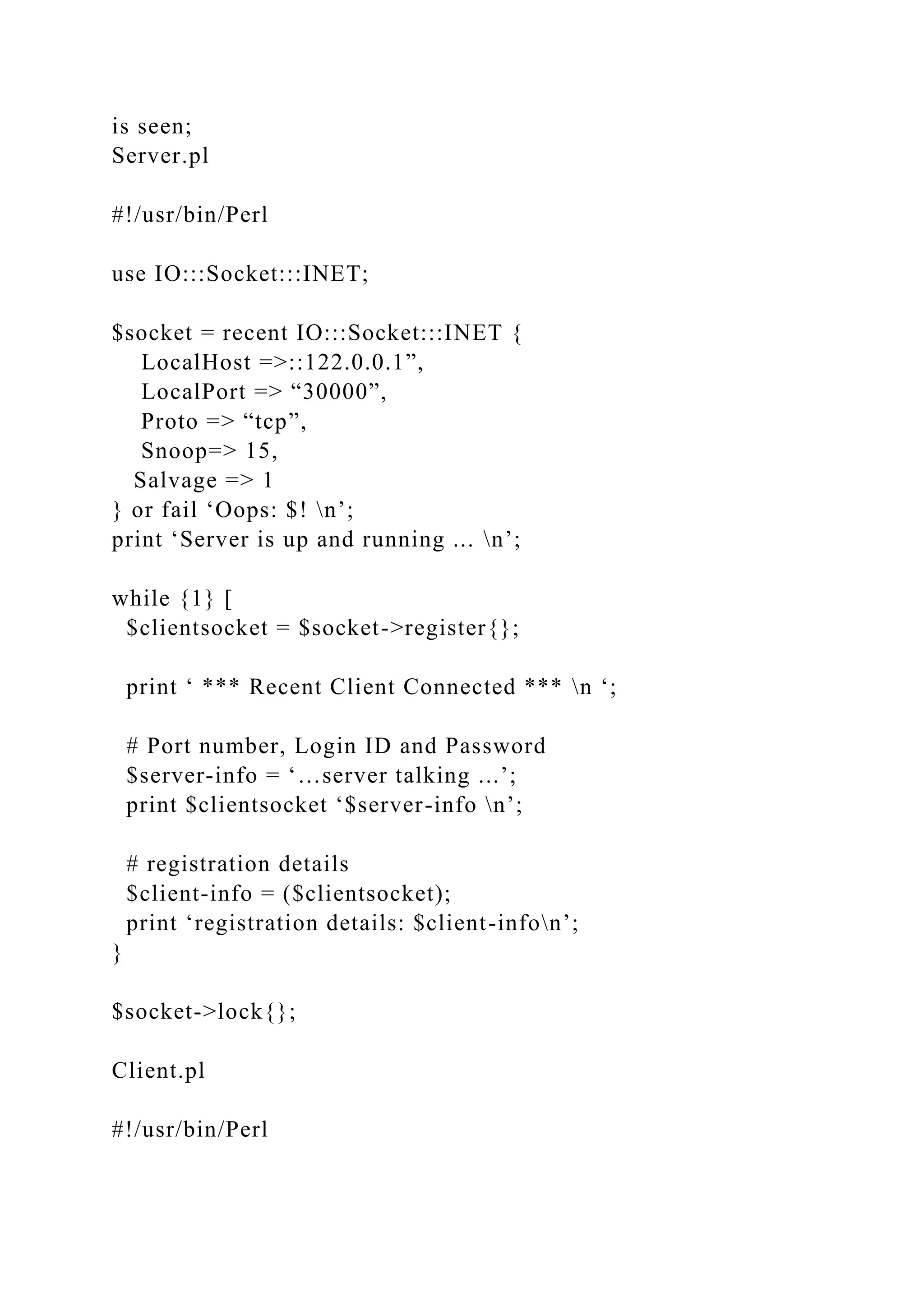

![last if m/^end/gi;
print "Received: $_";
print $address $_;
$result += $_;
]
chomp;
if {m/^end/gi} [
my $send = "result=$result";
print $address "$sendn";
print "Result: $sendn";
]
print "Locked connectionn";
lock $address;
print "At your service. Waiting...n";
]
Client script;
$remote = IO:::Socket:::INET->new{
Proto => 'tcp',
PeerAddress=> 'localhost',
PeerPort=> "8090",
Reuse => 1,
} or fail "$!";
print "Linked to ", $remote->peerhost,
" on port: ", $remote->peerport, "n";
$remote->autoflush{1};
while {<>} [
print $remote $_;
last if m/^end/gi;
my $line = <$remote>;
if {$line ne $_} [
print "Error in sending outputn";
exit;
]](https://image.slidesharecdn.com/runningheadimplementingthelistandsearchfeaturesinthedis-221101170613-35f616ef/75/Running-Head-IMPLEMENTING-THE-LIST-AND-SEARCH-FEATURES-IN-THE-DIS-docx-8-2048.jpg)
![]
my $res = <$remote>;
$res =~ m/result={d*}/gi;
print "Result: $1n";
print "Client terminatedn";
lock $remote
Client and server window screenshots to validate the
implementation.
Server window screenshot
References
Feddema, H. B. (2004). Expert one-on-one Microsoft Access
application development.
Indianapolis, IN: Wiley Pub..
Sugumaran, V. (2007). Application of agents and intelligent
information technologies. Hershey,
PA: Idea Group Pub..
Running Head: HANDLING CONCURRENT CLIENTS
HANDLING CONCURRENT CLIENTS 6
HANDLING CONCURRENT CLIENTS](https://image.slidesharecdn.com/runningheadimplementingthelistandsearchfeaturesinthedis-221101170613-35f616ef/75/Running-Head-IMPLEMENTING-THE-LIST-AND-SEARCH-FEATURES-IN-THE-DIS-docx-9-2048.jpg)
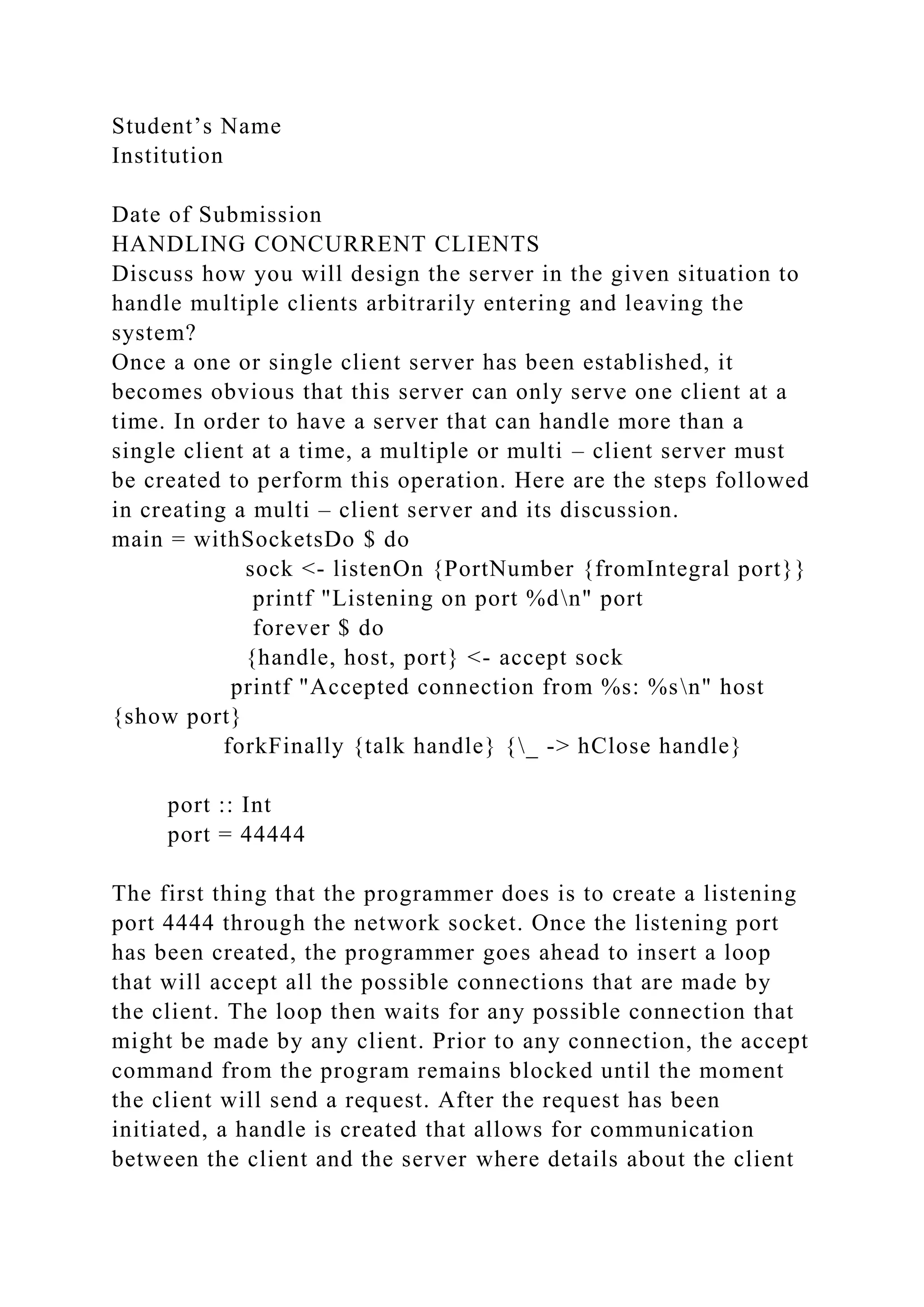
![are shared. The sharing of the client’s details enables a link to
be created between the server and the client in the form of a
binding, host to the client and port to the server. This binding
allows the client to log in to the server. Once the binding has
been made, the programmer creates a new thread that is
purposely made to handle the client’s requests. This becomes
folkfinally of the new thread formed. The interaction between
the client and the server henceforth is assigned to talk where the
handle returns after a connection call is accepted.
Describe your server design in detail.
There are four possible designs that allows for ease in handling
concurrent clients. Among the four, my choice of design is
design four that uses the STM. STM is a design that has seen
improvement from design three that uses broadcast chan. In this
design, the channel for communication between the client and
the server is avoided by storing in TVar all factors that are at
the moment.
Justification of STM Design
In STM the use of TVar reflects this on the screen:
newtype State = State [ currentFactor :: TVar Int ]
The reason for using STM design has been contributed by its
ability to block changes until something happens. Due to this it
spares the server the need to send messages overtly when a
change is made. In order to understand this, let’s follow the
explanation below:
When a client makes a sequence of events (N) to the server, the
following happens;
· The Handle receives N commands from the client and sends it
to the TChan thread of the server.
· Once received, the server makes a command on its TChan and
starts modifying the current factors in TVar.
· All the respective threads made acknowledge the changes
observed in TVar and forward the changed value back to the](https://image.slidesharecdn.com/runningheadimplementingthelistandsearchfeaturesinthedis-221101170613-35f616ef/75/Running-Head-IMPLEMENTING-THE-LIST-AND-SEARCH-FEATURES-IN-THE-DIS-docx-11-2048.jpg)
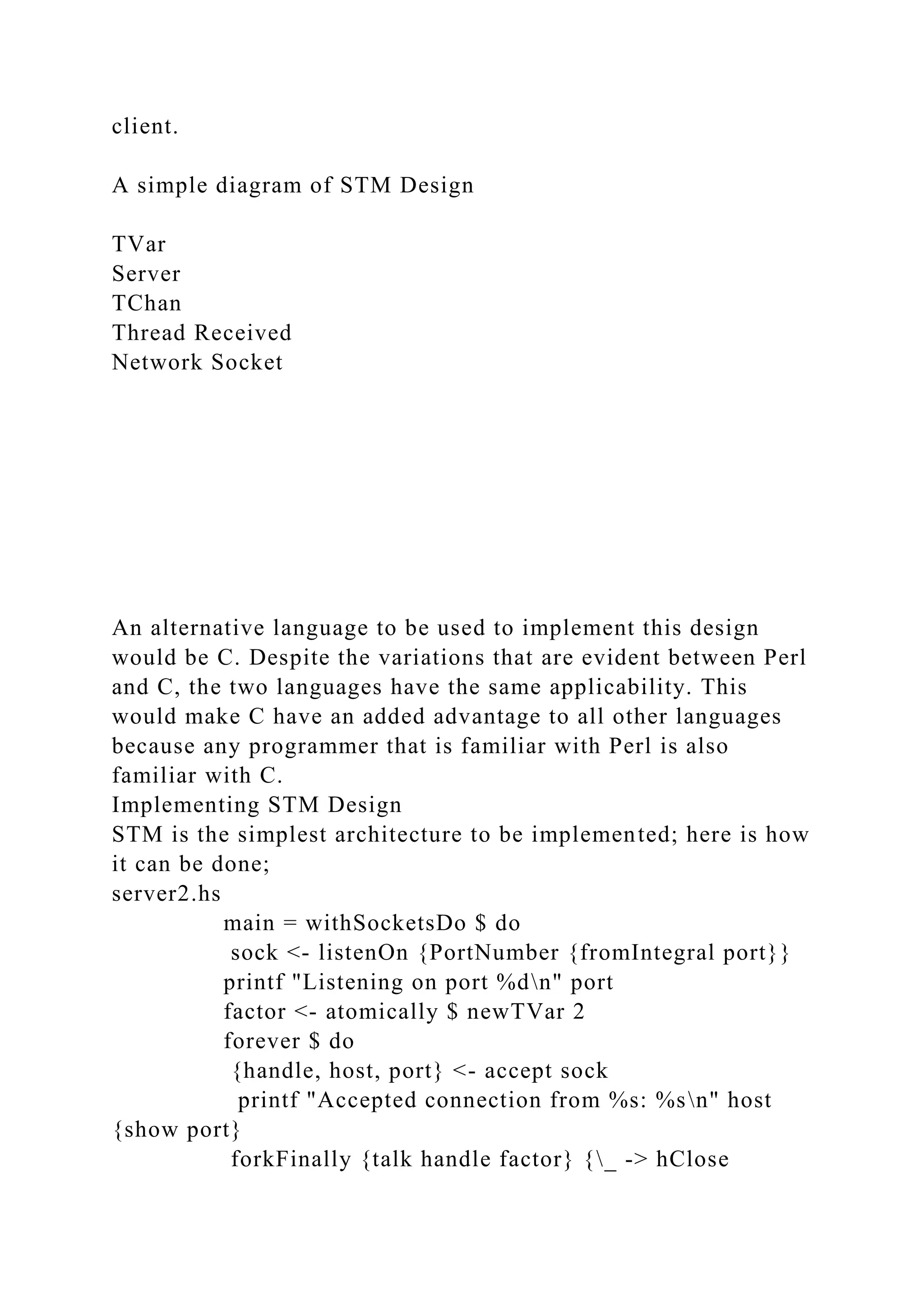
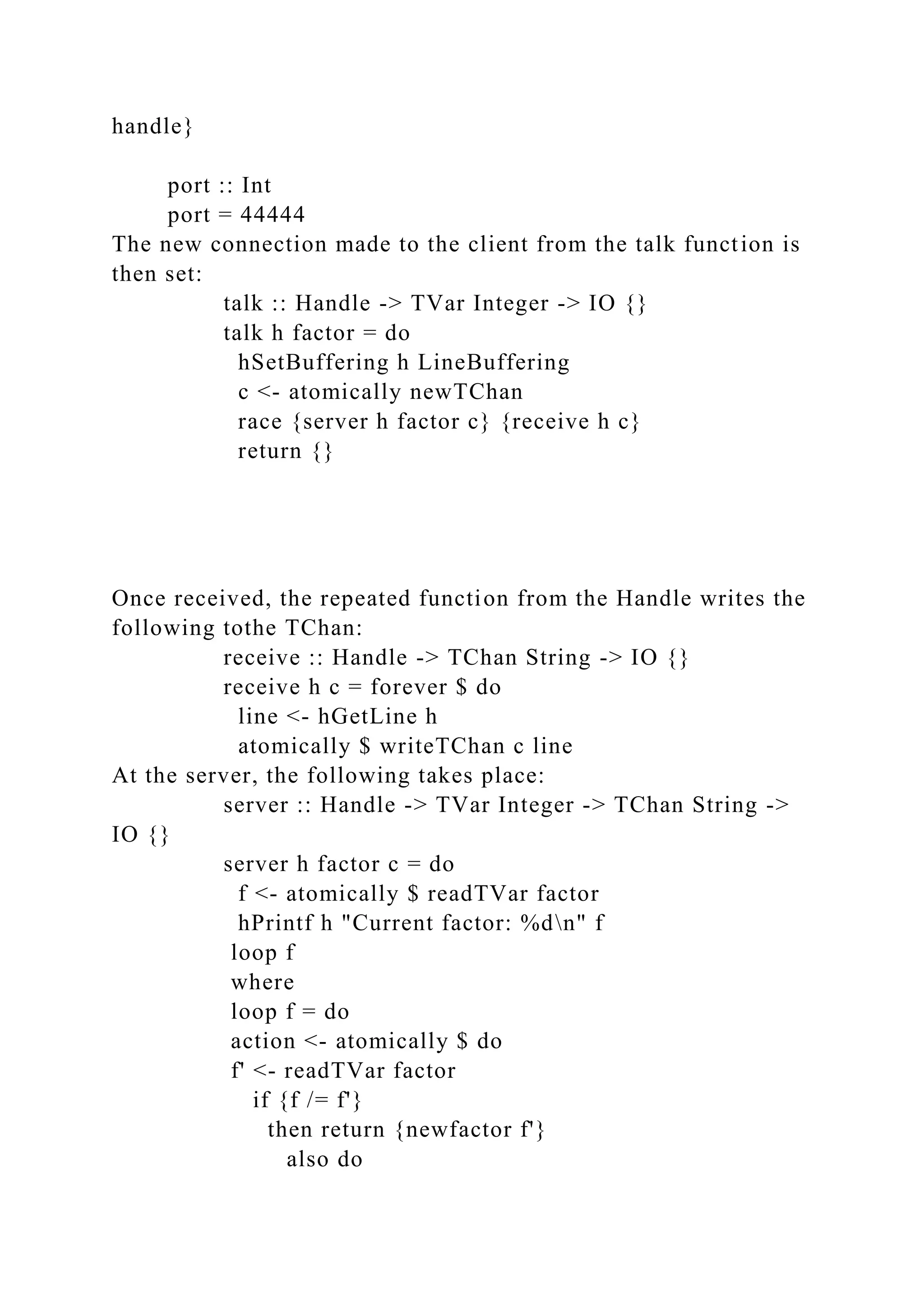
![l <- readTChan c
return {command f l}
action
newfactor f = do
hPrintf h "new factor: %dn" f
loop f
command f s
= case s of
"end" ->
hPutStrLn h {"Thank you for using the " ++
"Perl doubling service."}
'*':s -> do
atomically $ writeTVar factor [read s :: Integer]
loop f
line -> do
hPutStrLn h {show {f * {read line :: Integer}}}
loop f
There is no challenging task to in implementing STM design
since it’s the simplest design compared to the other three. This
is made possible by its ability to block any changes before any
command takes place.
Running Head: HANDLING CONCURRENT CLIENTS
HANDLING CONCURRENT CLIENTS 6
HANDLING CONCURRENT CLIENTS
Student’s Name](https://image.slidesharecdn.com/runningheadimplementingthelistandsearchfeaturesinthedis-221101170613-35f616ef/75/Running-Head-IMPLEMENTING-THE-LIST-AND-SEARCH-FEATURES-IN-THE-DIS-docx-14-2048.jpg)
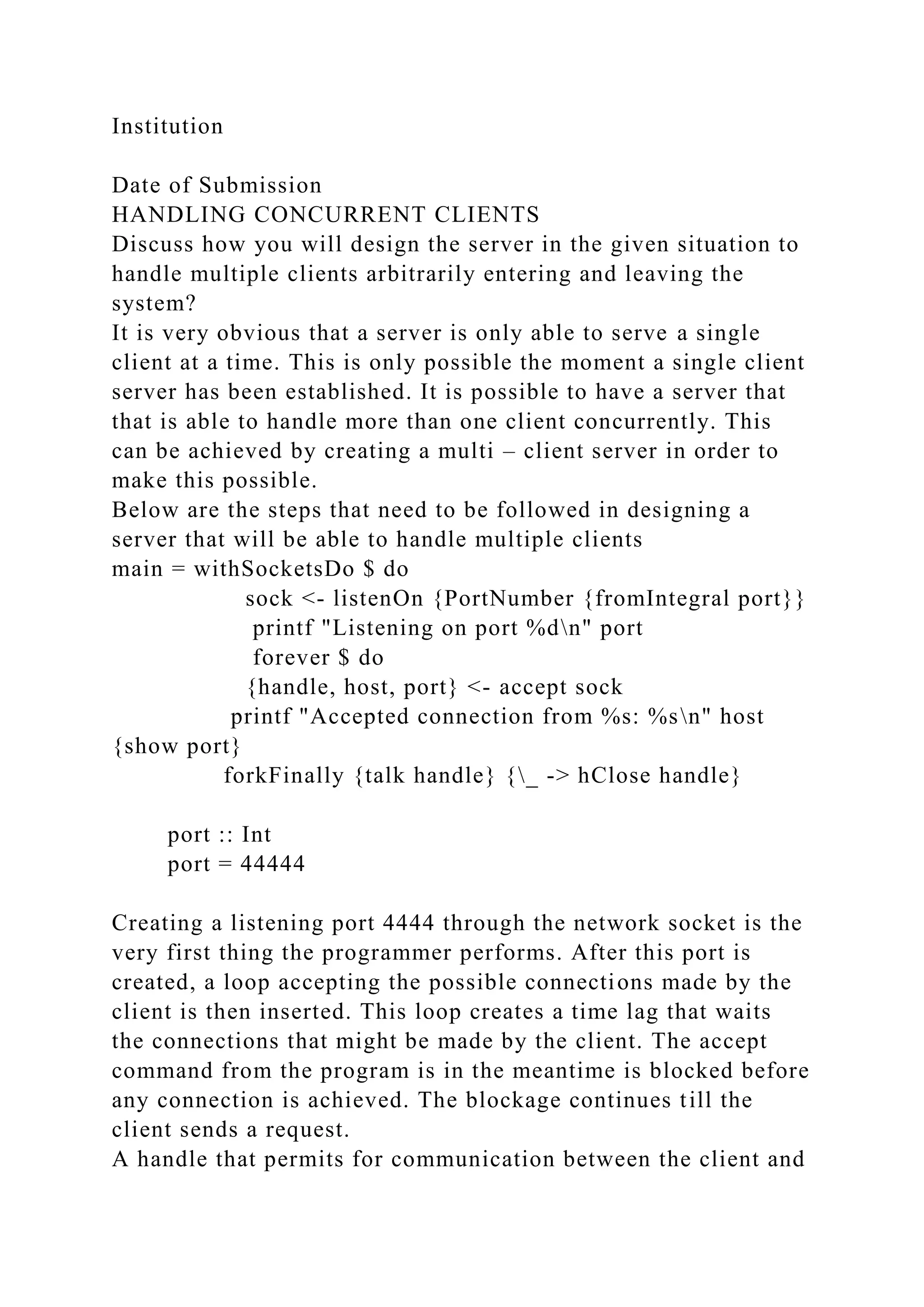
![the server is created: and this takes place after the initiation of
request.it is here where the client’s information sharing takes
place. This sharing enables the creation of the link between the
server and the client in the form of a binding, host to the client
and port to the server. This binding allows the client to log in to
the server. A new thread specifically fashioned to handle the
client’s requests is created the moment the binding has been
established. This becomes folkfinally of the new thread formed.
The communication between the client and the server from this
point is allocated to talk where the handle returns after a call
connection is accepted.
Describe your server design in detail.
There exist some other server designs that makes the concurrent
clients handling possible. This all depends with the design used
as some are not easy to implement. The best server design
choice that works best for me is the STM design. Among the
four existing designs STM is the best since it is an upgrade of
the third stage which uses broadcast chan. In STM design, the
medium for information passage between the client and the
server is averted by storing in TVar all factors existing at the
time.
Justification of STM Design
In this design the use of TVar displays the following on the
screen:
newtype State = State [ currentFactor :: TVar Int ]
The STM ability to block changes until something takes place is
the primary reason for its choice. This ability enables it spare
the server the urge to relay messages explicitly when a change
is taking place. This is further explained below
When a client makes a sequence of events (N) to the server, the
following happens;
· The Handle receives N commands from the client and sends it
to the TChan thread of the server.
· Once received, the server makes a command on its TChan and](https://image.slidesharecdn.com/runningheadimplementingthelistandsearchfeaturesinthedis-221101170613-35f616ef/75/Running-Head-IMPLEMENTING-THE-LIST-AND-SEARCH-FEATURES-IN-THE-DIS-docx-16-2048.jpg)
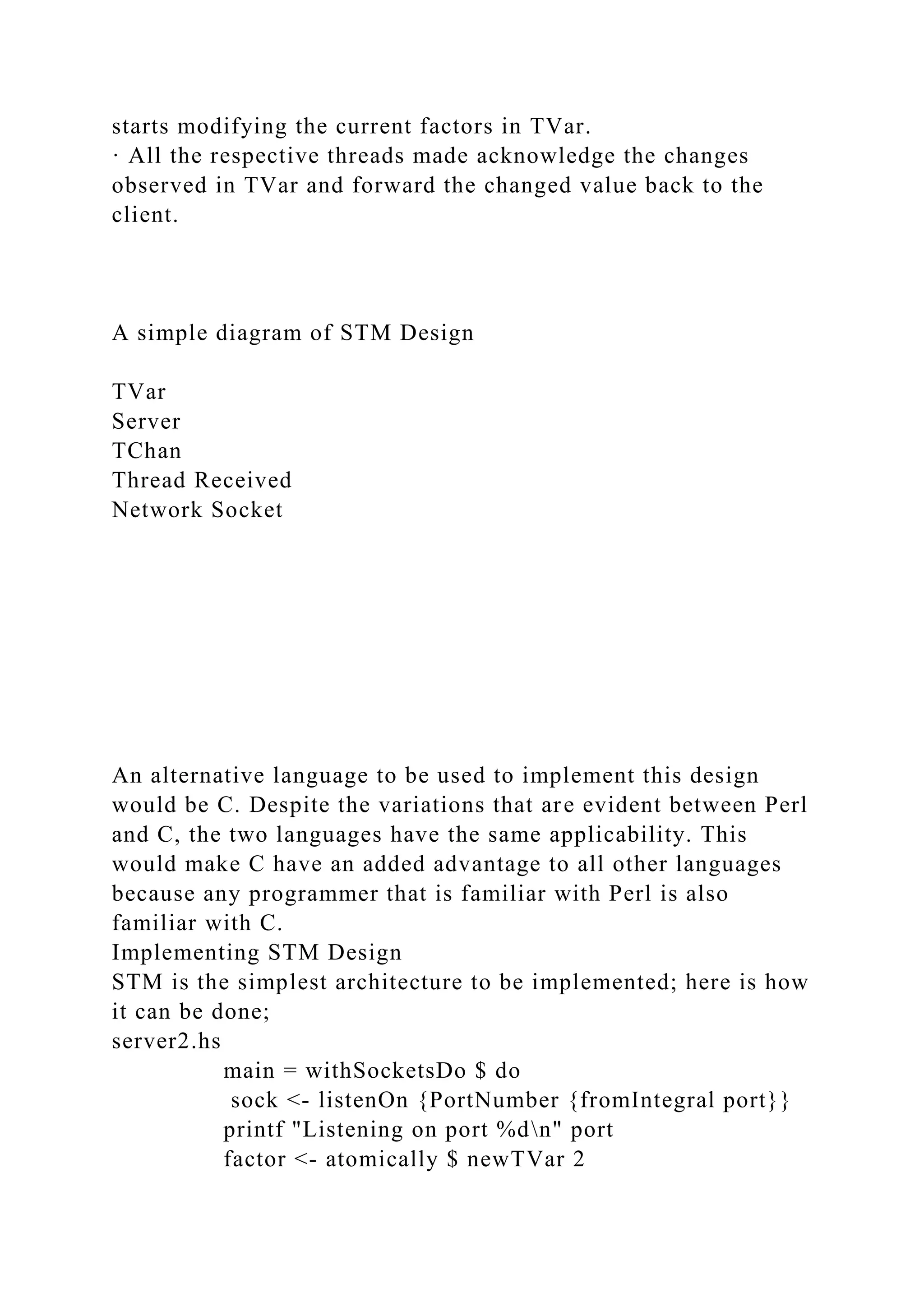
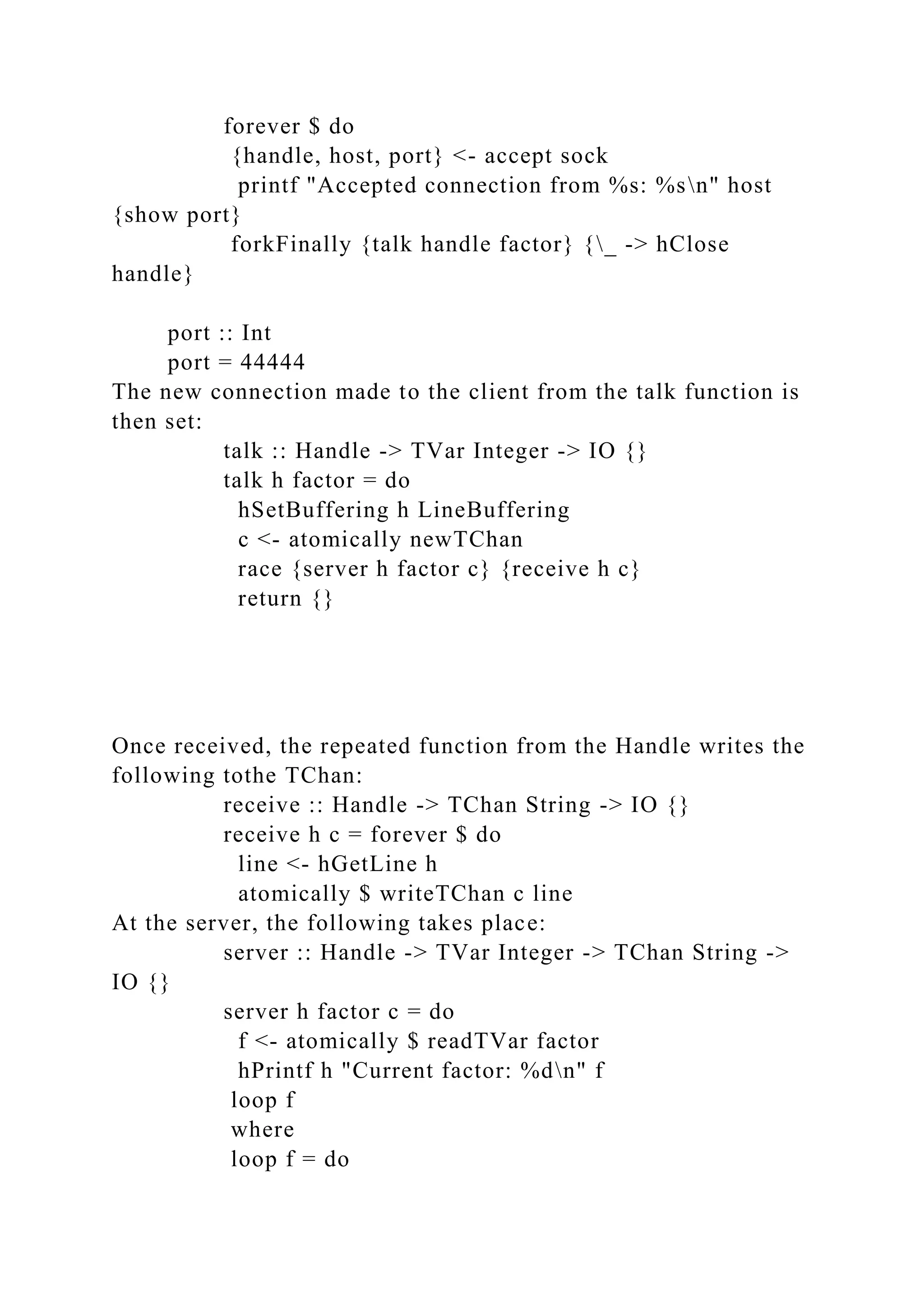
![action <- atomically $ do
f' <- readTVar factor
if {f /= f'}
then return {newfactor f'}
also do
l <- readTChan c
return {command f l}
action
newfactor f = do
hPrintf h "new factor: %dn" f
loop f
command f s
= case s of
"end" ->
hPutStrLn h {"Thank you for using the " ++
"Perl doubling service."}
'*':s -> do
atomically $ writeTVar factor [read s :: Integer]
loop f
line -> do
hPutStrLn h {show {f * {read line :: Integer}}}
loop f
There is no challenging task to in implementing STM design
since it’s the simplest design compared to the other three. This
is made possible by its ability to block any changes before any
command takes place.](https://image.slidesharecdn.com/runningheadimplementingthelistandsearchfeaturesinthedis-221101170613-35f616ef/75/Running-Head-IMPLEMENTING-THE-LIST-AND-SEARCH-FEATURES-IN-THE-DIS-docx-19-2048.jpg)